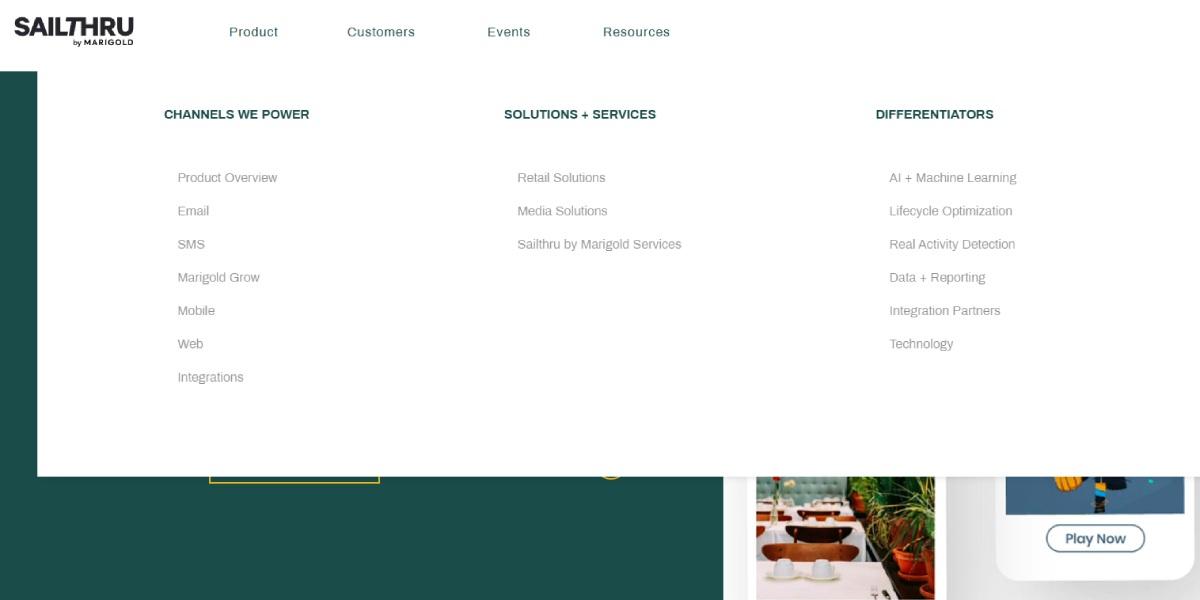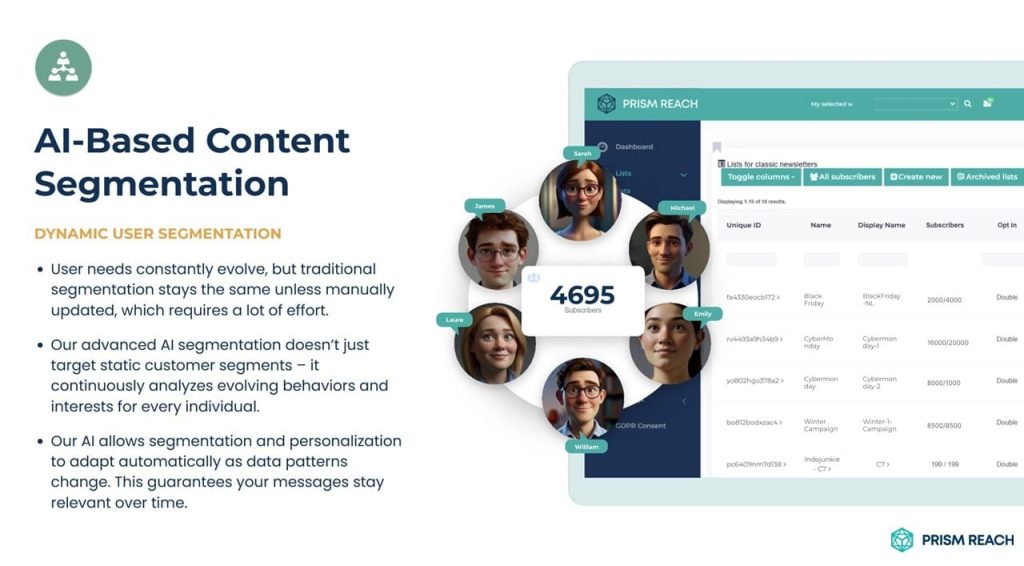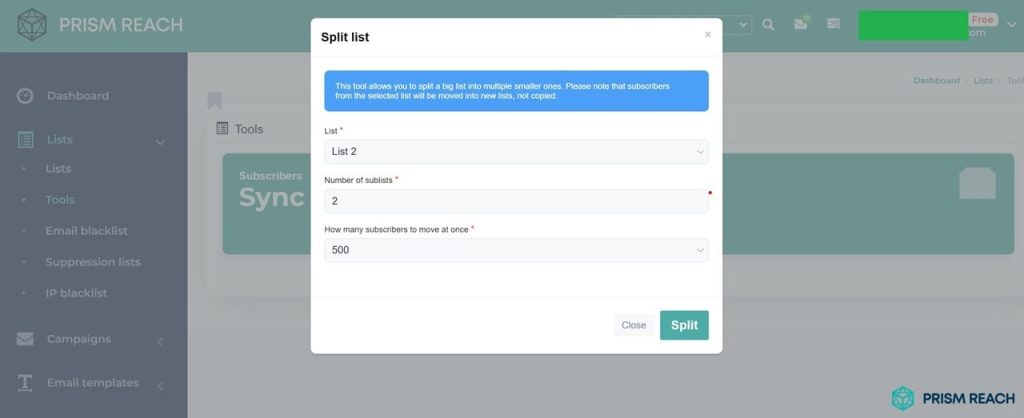Email marketing continues to be a vital component of digital strategies, driving engagement, fostering customer loyalty, and generating substantial revenue. Selecting the right marketing automation platform is crucial for achieving these objectives effectively. Sailthru and Listrak are two leading platforms in this space, each offering unique features tailored to different user needs. While Sailthru excels in omnichannel personalization and predictive analytics, Listrak shines in identity resolution and behavioral targeting, particularly beneficial for e-commerce businesses.
Beyond their standard features, both platforms harbor “hidden gems”—strategies and functionalities that are not widely recognized but can significantly enhance your marketing automation efforts. Integrating these hidden gems can provide a competitive edge, ensuring your marketing campaigns are more effective and efficient. Additionally, Prism Reach emerges as an innovative AI-powered tool designed to enhance email personalization and engagement, offering a compelling alternative or complement to Sailthru and Listrak.
Key Facts
Understanding the fundamental differences between Sailthru and Listrak is essential before diving into advanced strategies. Here’s a snapshot comparison:
- Target Audience: Sailthru excels in omnichannel personalization, integrating email, mobile, social, and website experiences, making it ideal for large enterprises and media companies. Listrak specializes in identity resolution and behavioral targeting, particularly beneficial for e-commerce businesses looking to enhance their marketing automation.
- Features: Sailthru offers advanced predictive analytics, dynamic content personalization, and comprehensive customer journey mapping. Listrak provides robust multi-channel campaign management, identity resolution, and a powerful recommendation engine tailored for e-commerce.
- Pricing: Sailthru’s pricing is highly customizable, catering primarily to large enterprises with complex needs. Listrak utilizes a structured pricing model, typically ranging from $20,000 to $150,000 annually, depending on the company size and feature requirements, making it accessible for mid-to-large e-commerce businesses.
Both platforms offer extensive support and resources, allowing users to maximize their marketing automation efforts. However, their distinct feature sets and pricing structures make them suitable for different organizational sizes and marketing complexities.
Comparative Analysis: Sailthru vs Listrak
Sailthru and Listrak adopt fundamentally different approaches to marketing automation, each excelling in their respective domains. Understanding these differences is key to leveraging their full potential.
Sailthru: Omnichannel Personalization and Predictive Analytics
Sailthru distinguishes itself with a comprehensive omnichannel approach, enabling unified customer experiences across email, mobile, social, and website touchpoints. Its strengths include:
- Predictive Analytics: Sailthru’s predictive analytics forecast customer behavior, allowing businesses to tailor marketing strategies based on which customers are likely to engage or convert.
- Dynamic Content Personalization: Offers dynamic content blocks that personalize messages based on real-time user data, enhancing relevance and engagement.
- Customer Journey Mapping: Utilizes advanced customer journey mapping to automate user journeys based on interactions, ensuring relevant content is delivered at each stage.
- Multi-Channel Integration: Seamlessly integrates email, mobile, social, and web channels to provide a cohesive marketing strategy across platforms.
- Advanced Segmentation: Enables detailed segmentation based on user behavior, demographics, and engagement history for more targeted campaigns.
Listrak: Identity Resolution and Behavioral Targeting for E-commerce
Listrak focuses on delivering powerful identity resolution and behavioral targeting capabilities, making it a preferred choice for e-commerce businesses. Its key strengths include:
- Behavioral Targeting: Leverages user behavior data to create highly targeted campaigns that resonate with individual customers.
- Identity Resolution: Accurately identifies and tracks customer interactions across multiple channels, providing a unified view of each customer.
- Recommendation Engine: Utilizes a robust recommendation engine to deliver personalized product suggestions, enhancing the shopping experience and increasing sales.
- Multi-Channel Campaign Management: Supports email, SMS, social media, and more, enabling comprehensive campaign management from a single platform.
- Advanced Automation: Offers sophisticated automation workflows that streamline marketing processes and ensure timely, relevant communication with customers.


Integrating Hidden Gems: Strategies to Enhance Marketing Automation
Both Sailthru and Listrak offer standard functionalities, but unlocking their hidden gems can significantly boost your marketing automation performance. Here are five strategies that can transform your campaigns:
1. Leverage Sailthru’s Predictive Analytics
Potential Effectiveness: High
Level of Obscurity: Moderate
Ease of Implementation: Moderate
Uniqueness: Unique
Utilize Sailthru’s predictive analytics to forecast customer behavior and tailor your marketing strategies accordingly. This feature helps identify which customers are likely to engage or convert, allowing for more targeted campaigns.
2. Implement Dynamic Content in Listrak
Potential Effectiveness: High
Level of Obscurity: Moderate
Ease of Implementation: Moderate
Uniqueness: Unique
Use Listrak’s dynamic content capabilities to personalize emails based on real-time user data. This allows you to show different products or messages to different segments of your audience, enhancing relevance and engagement.
3. Use Behavioral Triggers in Sailthru
Potential Effectiveness: High
Level of Obscurity: Low
Ease of Implementation: Easy
Uniqueness: Common but effective
Set up behavioral triggers in Sailthru to automatically send messages based on user actions, such as browsing behavior or previous purchases. This timely engagement can significantly increase conversion rates.
4. Create Multi-Channel Campaigns with Listrak
Potential Effectiveness: High
Level of Obscurity: Moderate
Ease of Implementation: Moderate
Uniqueness: Unique
Leverage Listrak’s multi-channel capabilities to create cohesive campaigns that engage users through email, SMS, and social media. This integrated approach ensures a consistent brand message across all platforms.
5. Automate Customer Journeys in Sailthru
Potential Effectiveness: High
Level of Obscurity: Moderate
Ease of Implementation: Moderate
Uniqueness: Unique
Utilize Sailthru’s customer journey mapping features to automate user journeys based on their interactions with your brand. This ensures that users receive relevant content at each stage of their journey, improving retention and satisfaction.

Prism Reach: Enhancing Marketing Automation with AI
While Sailthru and Listrak offer robust solutions for marketing automation, Prism Reach introduces a new dimension with its AI-powered personalization capabilities. Designed to bridge the gap between comprehensive marketing features and advanced personalization, Prism Reach provides deep customization that can enhance any marketing strategy.
Key Benefits of Prism Reach
- Increased Engagement: Publishers report up to 40% higher engagement rates due to the personalized nature of the content.
- Higher Revenue: Tailored advertising and efficient content targeting lead to higher monetization rates for published newsletters.
- Improved Productivity: Automation and AI-driven insights significantly reduce the time required to create and manage campaigns.
Integrating Prism Reach with Sailthru and Listrak
Prism Reach can complement both Sailthru and Listrak by adding advanced personalization and AI-driven insights to your marketing automation efforts. Whether you’re looking to enhance your predictive analytics in Sailthru or leverage Listrak’s behavioral targeting, Prism Reach offers tools that can elevate your campaigns.
For instance, using Prism Reach’s AI-powered scheduling can optimize send times based on subscriber behavior, ensuring your emails reach recipients when they’re most likely to engage. Additionally, Prism Reach’s dynamic content selection can automatically tailor newsletter content to individual subscriber preferences, enhancing relevance and engagement.
Upgrade Your Email Marketing with AI Personalization!
Practical Tips for Maximizing Marketing Automation
To fully leverage the capabilities of Sailthru, Listrak, and Prism Reach, consider the following practical tips:
- Combine Predictive Analytics with AI Personalization: Use Sailthru’s predictive analytics to forecast customer behavior, then apply Prism Reach’s AI to personalize content within each campaign.
- Implement Dynamic Content and Behavioral Triggers: Utilize Listrak’s dynamic content capabilities alongside Sailthru’s behavioral triggers to enhance personalization and timely engagement.
- Automate Multi-Channel Journeys: Leverage Listrak’s multi-channel campaign management with Sailthru’s customer journey mapping and Prism Reach’s AI-driven insights to create seamless, automated customer experiences across all touchpoints.
Choosing the Right Platform for Your Needs
The decision between Sailthru and Listrak hinges on your specific requirements and marketing goals. Here’s a breakdown to guide your choice:
When to Choose Sailthru
- Omnichannel Personalization: If your business requires a unified customer experience across email, mobile, social, and web channels, Sailthru’s comprehensive omnichannel approach is ideal.
- Predictive Analytics: Businesses looking to leverage predictive insights to forecast customer behavior and tailor their marketing strategies will benefit from Sailthru’s advanced analytics.
- Customer Journey Mapping: For organizations aiming to automate and personalize user journeys based on interactions, Sailthru offers robust customer journey mapping features.
When to Choose Listrak
- Identity Resolution: If your marketing strategy relies heavily on accurately identifying and tracking customer interactions across multiple channels, Listrak’s identity resolution capabilities are highly advantageous.
- Behavioral Targeting for E-commerce: E-commerce businesses seeking to enhance their marketing automation with behavioral targeting and personalized product recommendations will find Listrak’s features particularly beneficial.
- Multi-Channel Campaign Management: For businesses aiming to manage and execute campaigns across various channels from a single platform, Listrak provides comprehensive multi-channel campaign management tools.

Enhancing Your Strategy with Prism Reach
Regardless of whether you choose Sailthru or Listrak, integrating Prism Reach can significantly enhance your marketing automation strategy. Here are three specific benefits of Prism Reach that are relevant to this comparison:
- Deep Personalization: Prism Reach’s AI-powered user avatars and personalized introductions ensure each subscriber receives content tailored to their preferences, bridging the gap between Sailthru’s predictive analytics and Listrak’s behavioral targeting.
- Optimized Send Times: Using predictive analytics, Prism Reach identifies the best times to send newsletters, maximizing open and engagement rates across both platforms.
- Seamless Integration: Prism Reach can be easily integrated with both Sailthru and Listrak, enhancing their native capabilities without disrupting existing workflows, allowing for a more unified and efficient marketing strategy.
Conclusion
The choice between Sailthru and Listrak ultimately depends on the specific needs, resources, and goals of each organization. Sailthru excels in omnichannel personalization and predictive analytics, making it an excellent choice for businesses seeking a holistic marketing solution that integrates multiple channels seamlessly. On the other hand, Listrak provides unparalleled depth in identity resolution and behavioral targeting, particularly beneficial for e-commerce businesses aiming to enhance their marketing automation efforts through targeted campaigns.
However, the emergence of innovative tools like Prism Reach highlights the evolving nature of email marketing automation. By incorporating AI-powered personalization and deep engagement strategies, Prism Reach offers a compelling alternative that bridges the gap between Sailthru’s predictive capabilities and Listrak’s behavioral targeting. Whether you choose Sailthru, Listrak, or integrate Prism Reach, the key is to align your choice with your specific marketing goals, technical expertise, and the unique needs of your audience.
Ultimately, leveraging the hidden gems within these platforms and integrating advanced tools like Prism Reach can transform your marketing automation efforts, leading to higher engagement, increased revenue, and a more loyal customer base.